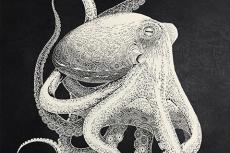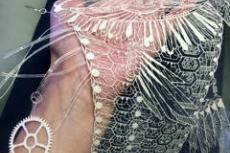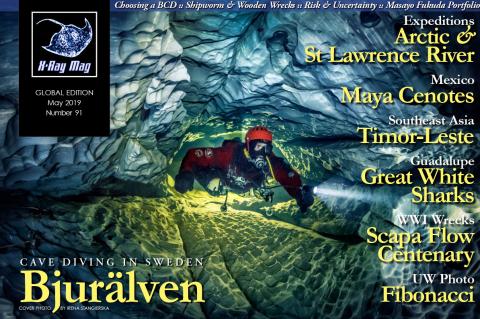Masayo Fukuda Portfolio
Artist Masayo Fukuda of Tokyo is a master of kirie, the Japanese art of paper cutting. Her beautiful, delicate creations and intricate designs of marine life, cut by hand from a single sheet of paper, have been exhibited in Tokyo, Osaka and Paris, and featured in print, television and social media. X-Ray Mag interviewed the artist to learn more about her artwork and her creative process.
Tags & Taxonomy
"My role may be to increase the number of people interested in marine life and the beauty of the sea through my artwork."
— Masayo Fukuda
X-RAY MAG: Tell us about yourself, your background and how you became an artist.
MF: Ever since I was small, I liked to move my fingers, and I loved drawing and manga (Japanese comic books). I imitated manga characters and drew original characters by myself. I still like the work of the famous Japanese artist Katsuhiro Otomo even today.
When I was a high school student, I had my first encounter with paper cutting. When giving a birthday card to my friend, I felt that it was unsatisfactory to send just a square card. So, I cut the paper into a heart shape.
After that, when giving greeting cards to family members and friends, I discovered that it was not so easy to cut their cards and present them with motifs such as flower bouquets and girls' profiles.
X-RAY MAG: Why marine life and underwater themes? How did you come to these themes and how did you develop your style of paper cutting?
MF: I have liked creepy and mysterious creatures as well as marine life from an early age. Among them, I especially liked deep-sea fish and jellyfish, and made them motifs in my work. Through trial and error, I figured out how to portray a mysterious atmosphere with a sense of depth, and developed a delicate expression with a three-dimensional technique.
X-RAY MAG: What is your artistic method or creative process?
MF: The way to make a basic paper cutting is to first draw a sketch on thin paper, put it on top of a black sheet of paper, which will become the final work, and then cut the two pieces together. In the early days, I also did cutouts in the same way, but there was a limit to expressing thin lines with two cuttings. When the paper cutting was finished, it was more a two-dimensional work with no sense of depth. So, in order to better express a sense of depth, I draw a sketch directly onto white paper and cut only the one sheet. The work is done on white paper because the sketch is difficult to see if it is on black paper.
The most important thing is the "sketch." My work is either good or bad based on the sketch and its completeness. I think that it is a characteristic unique to my work, which other artists’ paper cuttings do not have. In my case, the completed product will be reversed, left to right, because I have to draw the sketch on the back side of the paper. A very important part of the process in creating the sketch is calculating the overall balance while considering the reversal, left to right.
When we talk about traditional paper cutting art, the works are two-dimensional and depthless. However, I would like to express depth and a three-dimensional feeling with my paper cutting art. Therefore, I make large works, carefully using the contrast of the thickness and thinness of the line.
To make one artwork, I combine white paper, artistic skill, cutting techniques with a three-dimensional feeling on one piece of paper. There might be a painter who has exceptional painting skills, or a paper cutting artist with excellent cutting skills, but I think that no one has the talents of both. An artist who can produce a three-dimensional feeling with one piece of paper is considered unusual.
X-RAY MAG: What is your relationship to the underwater world and coral reefs and where have you had your favorite experiences?
MF: Actually, I have never done scuba diving or snorkeling. However, I was born along Kujukuri Beach in Chiba Prefecture, which is a famous surfing spot. So, when I was a young child, the beach was my playground. I loved picking up seashells when I was young. I remember squatting down on the beach for hours and finding seashells. However, beautiful seashells such as those of shellfish were not found so much in Kujukurihama. Therefore, I longed to see the unusual creatures that I saw in illustrations.
Being the kind of child as I was, I cannot forget the excitement I felt when I saw sea anemones on the rocks at Katsuura for the first time. From a diver's perspective, they might be common creatures, but up until then, I had only seen them in illustrations, and I was amazed by the fact that sea anemones were alive—really!
X-RAY MAG: What are your thoughts on ocean conservation and coral reef management and how does your artwork relate to these issues?
MF: When I went to Okinawa, which is a famous resort area in Japan, I saw a lot of bleached corals. It was a very sad experience. Also, I feel uneasy about the news of marine pollution I have seen on television and the Internet, and the news of waves carrying lots of garbage.
My role may be to increase the number of people interested in marine life and the beauty of the sea through my artwork. In the future, I would like to make pieces with these ocean problems as their theme.
X-RAY MAG: What is the message or experience you want viewers of your artwork to have or understand?
MF: I stick to the eyes and the expressions of living things. In the constantly changing natural environment, wild creatures do not show anger or sadness against it. Nature accepts the way you are, and draws the line of evolving creatures that will continue to thrive. I am glad if anything is felt in the mind’s eye when such creatures look at you.
X-RAY MAG: What are the challenges and/or benefits of being an artist in the world today? Any thoughts or advice for aspiring artists in ocean arts?
MF: Since social networking services (SNS) have been developed, many artists have announced various artworks on social media. Because there are lots of rivals posting, it is not easy to find and evaluate one’s own originality within the crowd.
However, I say to all, please keep sharing posts, so that many people can see our work. Please do not become shy after getting better at your art or posting. Rather, please announce more and more with SNS that you like the artworks you like.
And actually go to the ocean and the aquarium. Please get inspiration—further your knowledge with various information from the Internet and books. Then the sea creatures will mean something to you. Please visit your favorite sea a lot and take inspiration from nature.
I'm sure all will be on your side and people will cheer you up.
X-RAY MAG: How do people/children respond to your works?
MF: I am very happy when children who see my artwork say, "I want to do paper cutting art, too!" Some of them have actually made a paper cutting and showed it to me.
For about 30 years, I have continued to create paper cutting art. I was told by one viewer the most joyful and unforgettable words: "I cannot explain your paper cutting art. Only you can do it because you like it. You are sure to have some important role in this world."
I was very happy to hear this, and at the same time, I decided to prepare myself to do paper cutting art more seriously than before.
X-RAY MAG: What are your upcoming events?
My artwork will be featured at the KIRIKEN Masayo solo exhibition in Tokyo, Japan, on 17-22 June 2019; and the Salon Art Shopping expo in Paris, France, on 18-20 October 2019.
X-RAY MAG: Any parting thoughts?
MF: From now on, I will devote myself everyday to producing paper cutting art. I am glad if my artwork inspires you and you feel something from it. If you like my artwork, please send me a message of support via SNS. It becomes vitality in art making. Thank you very much. ■
For more information, visit the artist’s website at: kiriken.thebecos.com/en/artist/
Download the full article ⬇︎










































